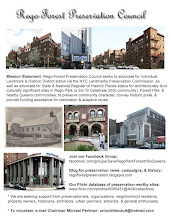 |
| Youthful visionaries at the QueensWay Mobile Workshop, Photo by Michael Perlman, Rego-Forest Preservation Council |
Our children
are our future. On March 29, Queens’ youth had a creative opportunity to shape
our borough’s future by illustrating and presenting their visions for the QueensWay,
which bears potential as a 3.5-mile linear elevated public park. The event was
held at the Metropolitan Expeditionary Learning School, which uniquely sits in
the foreground of a section of the abandoned LIRR Rockaway Beach Branch Line in
Forest Hills.
 |
| QueensWay conceptual rendering with children's play area, native trees, & wildflowers |
Along with numerous Queens residents, the
Trust For Public Land and Friends of The QueensWay envision converting an
abandoned stretch of tracks, depleted with weeds and trash into a multi-faceted
resource which Queens can pride as its symbolic representation of the 21st
century. This was one event among a series of QueensWay workshops and mobile workshops,
which the organizations hope will inspire Queens communities to contribute
ideas, pose questions, and receive feedback.
 |
| The Rockaway Beach Branch Line in Forest Hills as of 2011, Courtesy of Friends of The QueensWay |
 |
| Woodhaven Junction Station in 1950, Courtesy of Friends of The QueensWay |
In 1962, a small section of the line
succumbed to a fire, and city officials responded by decommissioning the entire
line. The conceived QueensWay would bridge central to southern Queens
communities, as it intersects Rego
Park, Forest Hills, Glendale, Woodhaven, Richmond Hill, and Ozone Park, and
also provide direct access to Forest Park. According to the Trust, the
QueensWay would serve 250,000 residents living within a mile, while fostering a
major economic boost to Queens.
Queens is a few steps closer to
the QueensWay, as evident by a number of recent developments. After New York State Governor Andrew
Cuomo awarded the Trust for Public Land a $467,000 to determine if the
QueensWay is feasible, it led to the commissioning of two planning and design
firms, WXY architecture + urban design and dlandstudio, which was recently
joined by Hester Street Collaborative, a community engagement nonprofit. The
organizations debuted preliminary design renderings at the Metropolitan
Expeditionary Learning School on March 24, followed by their presentation at
the High School For Construction Trades, Engineering and Architecture on March
26. To reach residents who are unable to attend major workshops, QueensWay
mobile workshops will continue to be held.
The March 29th
children’s mobile workshop was monitored by Shelma Jun of the Hester Street
Collaborative and joined by Friends of The QueensWay volunteers Travis Terry of
Forest Hills and Ruben Ramales of Woodhaven. Jun opened the QueensWay Mobile
Workshop toolkit, and across a communal table, displayed a foldout aerial map
bearing the neighborhoods that the QueensWay would intersect. She explained
what led to the tracks’ abandonment and how it has creative reuse potential. The
map was then reversed to reveal 10 photos which depict the area’s conditions and
its embankments.
Ramales explained, “You'll find yourself on grade in the
north. As it starts to work itself south, it’s pretty much earth embankments
until it hits Forest Park, which then becomes more of a ravine. It changes back
to earth embankments until it becomes an elevated viaduct.”
Jun explained how the areas vary
in width, and drew comparisons to the width of two school buses, an airplane,
or the Statue of Liberty. For example, the QueensWay is 72 feet wide near
Jamaica Avenue, but 133 feet wide adjacent to the Metropolitan Expeditionary
Learning School. “Where an area is really wide, we can introduce lots of
activities,” she said. In response, the children were presented with a map with
bold titled communities along the QueensWay, and were asked to place buttons pinpointing
activities which they could enjoy along specific stretches. The buttons ranged
from bird watching to garden spaces to food festivals.
The children were then handed a “QueensWay
History Coloring Book.” It illustrated the line’s origins to its abandonment, and
showed how some sections grew wild and others began housing businesses below. The
last steps enabled them to imagine how an old railroad can be transformed into
a park, and encouraged drawing what they would like to see in a circle. The
children created a pond with frogs and fish, trees, flowers, bike paths, a zip
line, and swings. Then they placed their 4 favorite program stickers, which
included nature walks, ecology classes, and picnic areas.
The event concluded with children
presenting their work and exhibiting much respect for each other’s visions. This
proved how community residents need to listen to each other’s views and work as
team players, to achieve a win-win solution for Queens.
“Through our QueensWay workshops,
we are coordinating fun activities for students in kindergarten through grade
12. We want to get ideas from kids in schools or afterschool programs, since
they can be very positive and creative,” said Ramales.
 |
| Conceptual renderings of the QueensWay |
 |
| Conceptual renderings of the QueensWay |
 |
| Conceptual renderings of the QueensWay |
A similar version of this feature appeared in Michael Perlman's Forest Hills Times column: http://www.foresthillstimes.com/view/full_story/24862255/article-Children-share-their-vision-for-QueensWay
You can advocate for a historical route and Queens' future by joining Friends of The QueensWay: https://www.facebook.com/TheQueensWay






No comments:
Post a Comment